Toxic Metals in Surface Dust in Underground Parking Garages: Pollution Status, Risk and Disease Burden Assessment, and Source Apportionment
Abstract
1. Introduction
2. Materials and Methods
2.1. Study Area
2.2. Sample Collection
2.3. Toxic Metal Analysis
2.4. Contamination Assessment
2.5. Potential Risk Assessment
| Exposure Parameters | Meaning | Unit | Children | Adult | Reference |
|---|---|---|---|---|---|
| BW | Body weight | kg | 15 | 61.5 | [25] |
| EF | Exposure frequency | d/a | 180 | 180 | [25] |
| ED | Exposure duration | a | 6 | 24 | [26] |
| IRinh | Inhalation rate | m3/d | 10 | 20 | [27] |
| IRing | Dust ingestion rate | mg/d | 200 | 100 | [26] |
| SA | Dermal exposure area | cm2 | 2800 | 5700 | [26] |
| AF | Dermal adherence factor | mg/cm2 | 0.2 | 0.07 | [26] |
| ABS | Dermal adsorption fraction | 0.13 | 0.13 | [26] | |
| AT | Averaging life span | d | 70 × 365 | 70 × 365 | [28] |
| PEF | Particle emission factor | M3/kg | 1.36 × 109 | 1.36 × 109 | [25] |
2.6. Disease Burden Assessment
2.7. Source Appointment
3. Results and Discussion
3.1. Toxic Metal Contents in UPGs Surface Dust
3.2. Pollution Status of Toxic Metals in UPGs Surface Dust
3.3. Non-Carcinogenic Risks Assessment
3.4. Disease Burden Assessment
3.5. Source Apportionment
3.6. Influence of Essntial Conditions on Toxic Metals in UPGs’ Surface Dust
3.7. Limitations and Future Research
4. Conclusions
Supplementary Materials
Author Contributions
Funding
Institutional Review Board Statement
Informed Consent Statement
Data Availability Statement
Conflicts of Interest
References
- Liu, Z.; Yin, H.; Ma, S.; Jin, G.; Gao, J.; Ding, W. On-site assessments on variations of PM2.5, PM10, CO2 and TVOC concentrations in naturally ventilated underground parking garages with traffic volume. Environ. Pollut. 2019, 247, 626–637. [Google Scholar] [CrossRef]
- Glorennec, P.; Bonvallot, N.; Mandin, C.; Goupil, G.; Pernelet-Joly, V.; Millet, M.; Filleul, L.; Le, M. Is a quantitative risk assessment of air quality in underground parking garages possible? Indoor Air 2008, 18, 283–292. [Google Scholar] [CrossRef] [PubMed]
- Kolakkandi, V.; Sharma, B.; Rana, A.; Dey, S.; Rawat, P.; Sarkar, S. Spatially resolved distribution, sources and health risks of heavy metals in size-fractionated road dust from 57 sites across megacity Kolkata, India. Sci. Total Environ. 2020, 705, 135805. [Google Scholar] [CrossRef] [PubMed]
- Tarafdar, A.; Oh, M.; Nguyen-Phuong, Q.; Kwon, J. Profiling and potential cancer risk assessment on children exposed to PAHs in playground dust/soil: A comparative study on poured rubber surfaced and classical soil playgrounds in Seoul. Environ. Geochem. Health 2020, 42, 1691–1704. [Google Scholar] [CrossRef] [PubMed]
- Cao, Z.; Wang, M.; Chen, Q.; Zhu, C.; Jie, J.; Li, X.; Dong, X.; Miao, Z.; Shen, M.; Bu, Q. Spatial, seasonal and particle size dependent variations of PAH contamination in indoor dust and the corresponding human health risk. Sci. Total Environ. 2019, 653, 423–430. [Google Scholar] [CrossRef]
- Li, J.; Wang, G.; Liu, F.; Cui, L.; Jiao, Y. Source Apportionment and Ecological-Health Risks Assessment of Heavy Metals in Topsoil Near a Factory, Central China. Expo. Health 2021, 13, 79–92. [Google Scholar] [CrossRef]
- Cai, L.; Wang, Q.; Luo, J.; Chen, L.; Zhu, R.; Wang, S.; Tang, C. Heavy metal contamination and health risk assessment for children near a large Cu-smelter in central China. Sci. Total Environ. 2019, 650, 725–733. [Google Scholar] [CrossRef]
- Duan, H.; Cai, X.; CHEN, Y.; Ruan, X.; Tong, Z.; Ma, J. Occurrence and health risk assessment of polycyclic aromatic hydrocarbons in surface dust from parks in Kaifeng, China. Acta Sci. Circumstantiae 2016, 36, 4500–4509. [Google Scholar]
- Duan, H.; Cai, X.; Ruan, X.; Tong, Z.; Ma, J. Assessment of Heavy Metal Pollution and Its Health Risk of Surface Dusts from Parks of Kaifeng, China. Environ. Sci. 2015, 36, 2972–2980. [Google Scholar]
- Ozaki, H.; Watanabe, I.; Kuno, K. As, Sb and Hg distribution and pollution sources in the roadside soil and dust around Kamikochi, Chubu Sangaku National Park, Japan. Geochem. J. 2004, 38, 473–484. [Google Scholar] [CrossRef]
- Donado, E.; Oliveira, M.; Goncalves, J.; Dotto, G.; Silva, L. Soil contamination in Colombian playgrounds: Effects of vehicles, construction, and traffic. Environ. Sci. Pollut. Res. 2021, 28, 166–176. [Google Scholar] [CrossRef]
- Chen, Y.; Cao, Z.; Covaci, A.; Li, C.; Cui, X. Novel and legacy flame retardants in paired human fingernails and indoor dust samples. Environ. Int. 2019, 133, 105227. [Google Scholar] [CrossRef]
- Jayarathne, A.; Egodawatta, P.; Ayoko, G.; Goonetilleke, A. Role of residence time on the transformation of Zn, Cu, Pb and Cd attached to road dust in different land uses. Ecotoxicol. Environ. Saf. 2018, 153, 195–203. [Google Scholar] [CrossRef] [PubMed]
- Hou, S.; Zheng, N.; Tang, L.; Ji, X.; Li, Y.; Hua, X. Pollution characteristics, sources, and health risk assessment of human exposure to Cu, Zn, Cd and Pb pollution in urban street dust across China between 2009 and 2018. Environ. Int. 2019, 128, 430–437. [Google Scholar] [CrossRef] [PubMed]
- Li, X.; Zhou, Q.; Sun, X.; Ren, W. Effects of cadmium on uptake and translocation of nutrient elements in different welsh onion (Allium fistulosum L.) cultivars. Food Chem. 2016, 194, 101–110. [Google Scholar] [CrossRef] [PubMed]
- Shabanda, I.; Koki, I.; Low, K.; Zain, S.; Khor, S.; Bakar, N. Daily exposure to toxic metals through urban road dust from industrial, commercial, heavy traffic, and residential areas in Petaling Jaya, Malaysia: A health risk assessment. Environ. Sci. Pollut. Res. 2019, 26, 37193–37211. [Google Scholar] [CrossRef]
- Li, X.; Zhang, M.; Gao, Y.; Zhang, Y.; Zhang, X.; Yan, X.; Wang, S.; Yang, R.; Liu, B.; Yu, H. Urban street dust bound 24 potentially toxic metal/metalloids (PTMs) from Xining valley-city, NW China: Spatial occurrences, sources and health risks. Ecotoxicol. Environ. Saf. 2018, 162, 474–487. [Google Scholar] [CrossRef]
- Jan, R.; Roy, R.; Yadav, S.; Stasangi, P. Chemical fractionation and health risk assessment of particulate matter-bound metals in Pune, India. Environ. Geochem. Health 2018, 40, 255–270. [Google Scholar] [CrossRef]
- Kong, Y.; Liu, J.; Pan, J.; Ruan, X.; Wang, Y. Migration characteristics and health risk assessment of heavy metals in soil-vegetable system in a typical wastewater irrigation area. J. Food Compos. Anal. 2025, 143, 107564. [Google Scholar] [CrossRef]
- Kouidri, M.; Dali, Y.; Benabdellah, I.; Ghoubali, R.; Bernoussi, A.; Lagha, A. Enrichment and geoaccumulation of heavy metals and risk assessment of sediments from coast of Ain Temouchent (Algeria). Arab. J. Geosci. 2016, 9, 354. [Google Scholar] [CrossRef]
- Ma, J.; Dong, Y.; Chen, Y. Background values of heavy metals in surface dusts in the vicinity of Kaifeng, Henan Province. Acta Sci. Circumstantiae 2020, 40, 1798–1806. [Google Scholar]
- Demirak, A.; Kocakaya, M.; Keskin, F. Chemical fractions of toxic metals and assessment of risks on the environment and health in Mugla topsoils. Int. J. Environ. Sci. Technol. 2022, 19, 5631–5648. [Google Scholar] [CrossRef]
- Rinklebe, J.; Antoniadis, V.; Shaheen, S.; Rosche, O.; Altermann, M. Health risk assessment of potentially toxic elements in soils along the Central Elbe River, Germany. Environ. Int. 2019, 126, 76–88. [Google Scholar] [CrossRef]
- Shaheen, S.; Abdelrazek, M.; Elthoth, M.; Moghanm, F.; Mohamed, R.; Hamza, A.; El-Habashi, N.; Wang, J.; Rinklebe, J. Potentially toxic elements in saltmarsh sediments and common reed (Phragmites australis) of Burullus coastal lagoon at North Nile Delta, Egypt: A survey and risk assessment. Sci. Total Environ. 2019, 649, 1237–1249. [Google Scholar] [CrossRef]
- Jiang, Y.; Hu, X.; Yves, U.; Zhan, H.; Wu, Y. Status, source and health risk assessment of polycyclic aromatic hydrocarbons in street dust of an industrial city, NW China. Ecotoxicol. Environ. Saf. 2014, 106, 11–18. [Google Scholar] [CrossRef] [PubMed]
- Soltani, N.; Keshavarzi, B.; Moore, F.; Tavakol, T.; Lahijanzadeh, A.; Jaafarzadeh, N.; Kermani, M. Ecological and human health hazards of heavy metals and polycyclic aromatic hydrocarbons (PAHs) in road dust of Isfahan metropolis, Iran. Sci. Total Environ. 2015, 505, 712–723. [Google Scholar] [CrossRef] [PubMed]
- Soclo, H.; Garrigues, P.; Ewald, M. Origin of polycyclic aromatic hydrocarbons (PAHs) in coastal marine sediments; case studies in Cotonou (Benin) and Aquitaine (France) areas. Mar. Pollut. Bull. 2000, 40, 387–396. [Google Scholar] [CrossRef]
- Bandowe, B.; Nkansah, M. Occurrence, distribution and health risk from polycyclic aromatic compounds (PAHs, oxygenated-PAHs and azaarenes) in street dust from a major West African Metropolis. Sci. Total Environ. 2016, 553, 439–449. [Google Scholar] [CrossRef]
- Li, Z.; Ma, Z.; Kuijp, T.; Yuan, Z.; Huang, L. A review of soil heavy metal pollution from mines in China: Pollution and health risk assessment. Sci. Total Environ. 2014, 468–469, 843–853. [Google Scholar] [CrossRef]
- Dehghani, S.; Moore, F.; Keshavarzi, B.; Hale, B. Health risk implications of potentially toxic metals in street dust and surface soil of Tehran, Iran. Ecotoxicol. Environ. Saf. 2017, 136, 92–103. [Google Scholar] [CrossRef]
- Jakobsen, L.; Granby, K.; Knudsen, V.; Nauta, M.; Pires, S.; Poulsen, M. Burden of disease of dietary exposure to acrylamide in Denmark. Food Chem. Toxicol. 2016, 90, 151–159. [Google Scholar] [CrossRef]
- Abtahi, M.; Dobaradaran, S.; Koolivand, A.; Jorfi, S.; Saeedi, R. Assessment of cause-specific mortality and disability-adjusted life years (DALYs) induced by exposure to inorganic arsenic through drinking water and foodstuffs in Iran. Sci. Total Environ. 2023, 856, 159118. [Google Scholar] [CrossRef]
- Xue, P.; Zhao, Y.; Zhao, D.; Chi, M.; Yin, Y.; Xuan, Y.; Wang, X. Mutagenicity, health risk, and disease burden of exposure to organic micropollutants in water from a drinking water treatment plant in the Yangtze River Delta, China. Ecotoxicol. Environ. Saf. 2021, 221, 112421. [Google Scholar] [CrossRef] [PubMed]
- Pan, S.; An, W.; Li, H.; Su, M.; Zhang, J.; Yang, M. Cancer risk assessment on trihalomethanes and haloacetic acids in drinking water of China using disability-adjusted life years. J. Hazard. Mater. 2014, 280, 288–294. [Google Scholar] [CrossRef] [PubMed]
- Lei, S.; Zheng, R.; Zhang, S.; Huang, Y.; Qiao, L.; Song, B.; He, Y.; Du, L.; Wang, N.; Xi, Y.; et al. Years lived with disability of cancer in China: Findings from disability weights measurement with a focus on the effect of disease burden. Sci. Bull. 2023, 68, 1430–1438. [Google Scholar] [CrossRef] [PubMed]
- Ma, J.; Shen, Z.; Wang, S.; Deng, L.; Sun, J.; Liu, P.; She, Z. Source apportionment of heavy metals in soils around a coal gangue heap with the APCS-MLR and PMF receptor models in Chongqing, southwest China. J. Mt. Sci. 2023, 20, 1061–1073. [Google Scholar] [CrossRef]
- Chen, Y.; Ma, J.; Dong, Y.; Liu, D.; Chen, X. Background Values of As and Hg in Surface Dusts in the Vicinity of Kaifeng City and Their Application. Environ. Sci. 2014, 35, 3052–3059. [Google Scholar]
- Pan, H.; Lu, X.; Lei, K. A comprehensive analysis of heavy metals in urban road dust of Xi’an, China: Contamination, source apportionment and spatial distribution. Sci. Total Environ. 2017, 609, 1361–1369. [Google Scholar] [CrossRef]
- Duan, H.; Shen, H.; Peng, C.; Ren, C.; Wang, Y.; Liu, D.; Wang, Y.; Guo, R.; Ma, J. Source Apportionment and Health Risk Assessment of Heavy Metals in Dust Around Bus Stops in Kaifeng City Based on APCS-MLR Model. Environ. Sci. 2023, 40, 3502–3511. [Google Scholar]
- Wang, H.; Yan, S.; Wu, K.; Tian, Y.; Hu, W.; Jiang, Y.; Li, C. Distribution Characteristics and Ecological Risk Assessment of Heavy Metals in Surface Dust from a University Campus in Kaifeng, China. Chin. J. Soil Sci. 2023, 54, 171–179. [Google Scholar]
- Jiang, Y.; Shi, L.; Guang, A.; Mu, Z.; Zhan, H.; Wu, Y. Contamination levels and human health risk assessment of toxic heavy metals in street dust in an industrial city in Northwest China. Environ. Geochem. Health 2018, 40, 2007–2020. [Google Scholar] [CrossRef]
- Wang, Y.; Yu, H.; Yi, M.; Zhou, R.; Li, H.; Xu, S.; Tang, J.; Wang, C. Spatial distribution, sources, and risks of heavy metals in soil from industrial areas of Hangzhou, eastern China. Environ. Earth Sci. 2023, 82, 95. [Google Scholar] [CrossRef]
- Verma, A.; Yadav, S. Chemical Speciation, Bioavailability and Human Health Risk Assessment of Metals in Surface Dust from an Industrial Cluster in India. Arch. Environ. Contam. Toxicol. 2023, 84, 267–283. [Google Scholar] [CrossRef]
- Tang, Z.; Chai, M.; Cheng, J.; Jin, J.; Yang, Y.; Nie, Z.; Huang, Q.; Li, Y. Contamination and health risks of heavy metals in street dust from a coal-mining city in eastern China. Ecotoxicol. Environ. Saf. 2017, 138, 83–91. [Google Scholar] [CrossRef]
- Lu, X.; Wu, X.; Wang, Y.; Chen, H.; Gao, P.; Fu, Y. Risk assessment of toxic metals in street dust from a medium-sized industrial city of China. Ecotoxicol. Environ. Saf. 2014, 106, 154–163. [Google Scholar] [CrossRef]
- Ni, L.; Cui, X.; Xu, L.; Lin, Q.; Guo, K. Study on distribution and enrichment of heavy metal elements in fly ash and slag from fuel coal. Coal Sci. Technol. 2020, 48, 203–208. [Google Scholar]

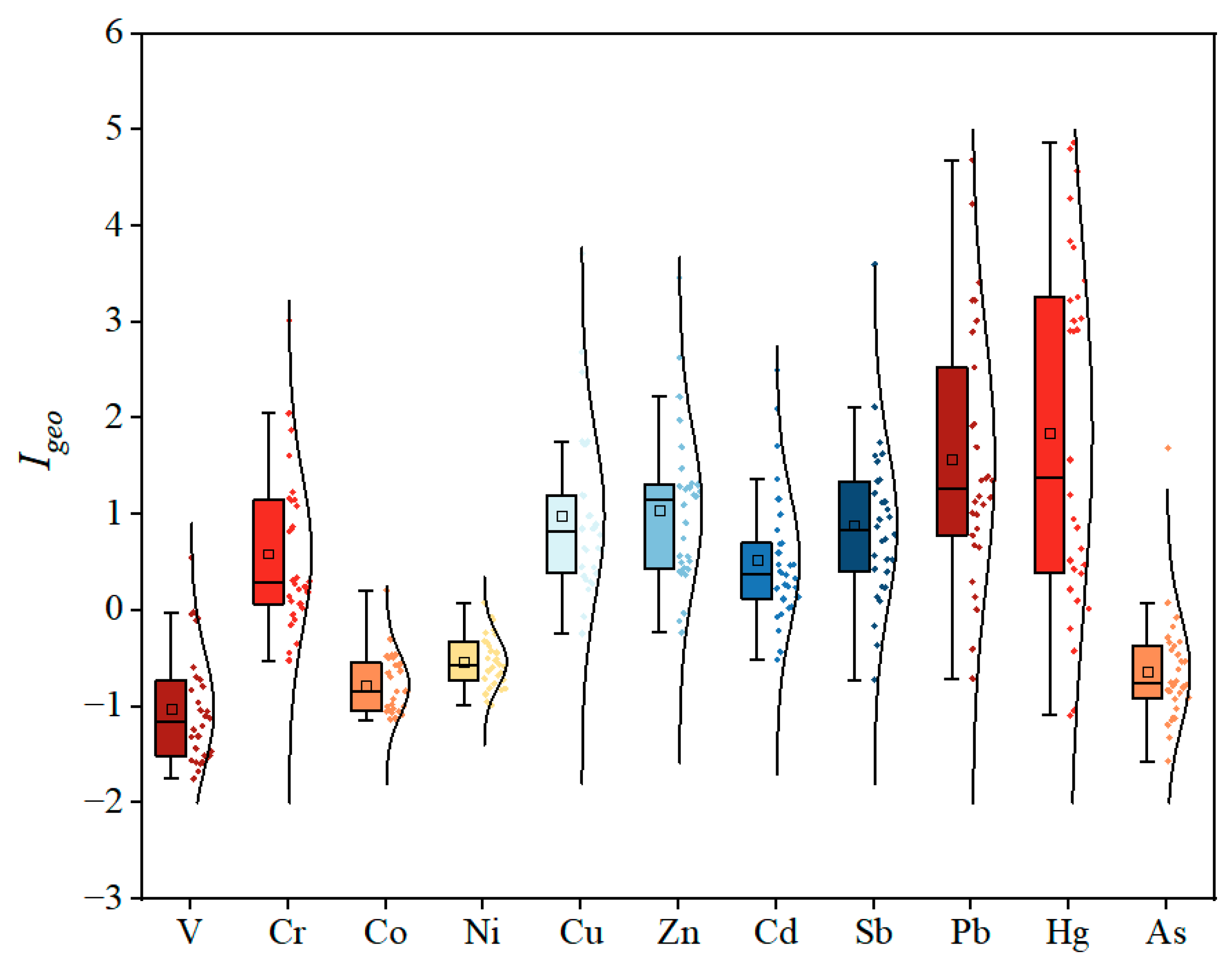
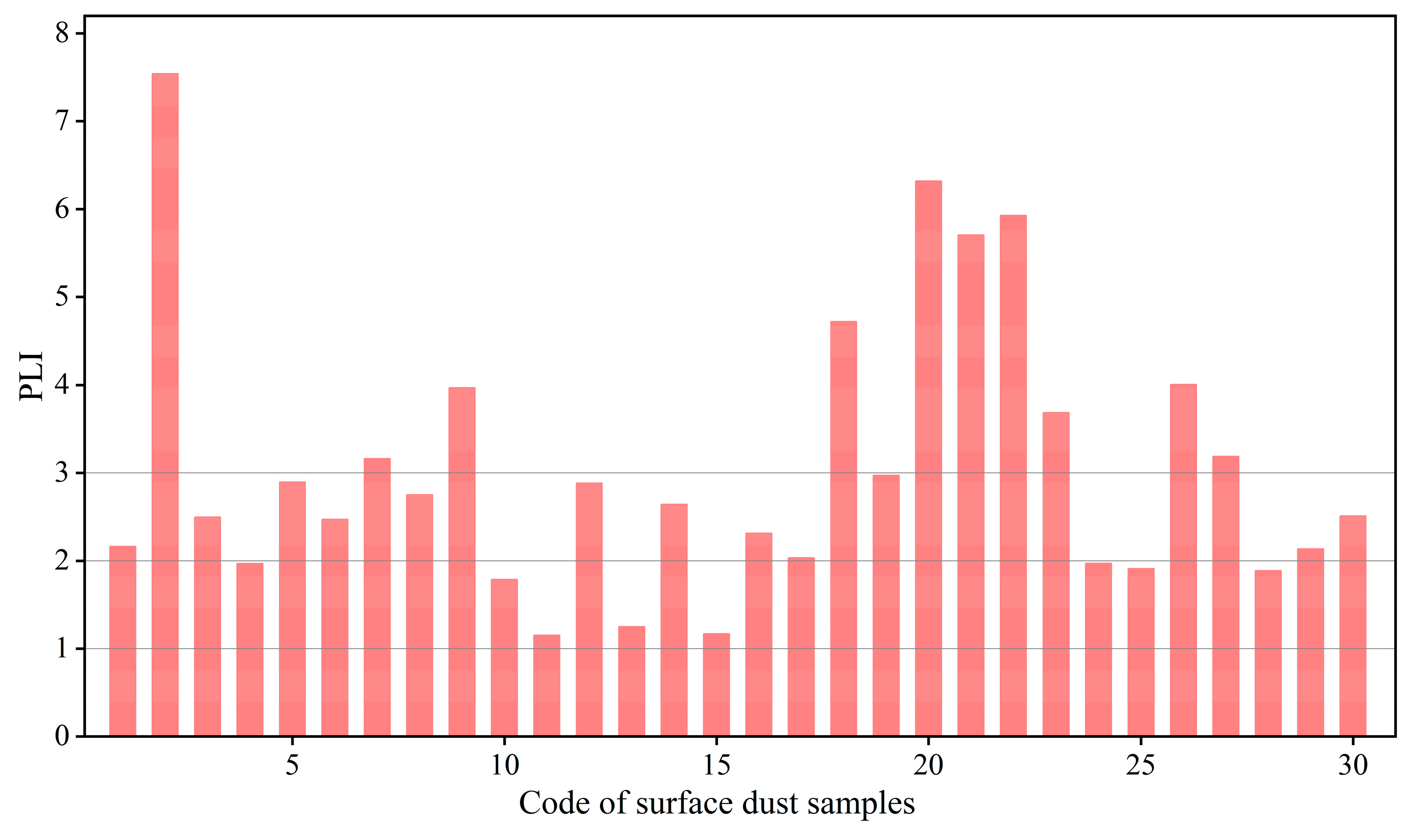
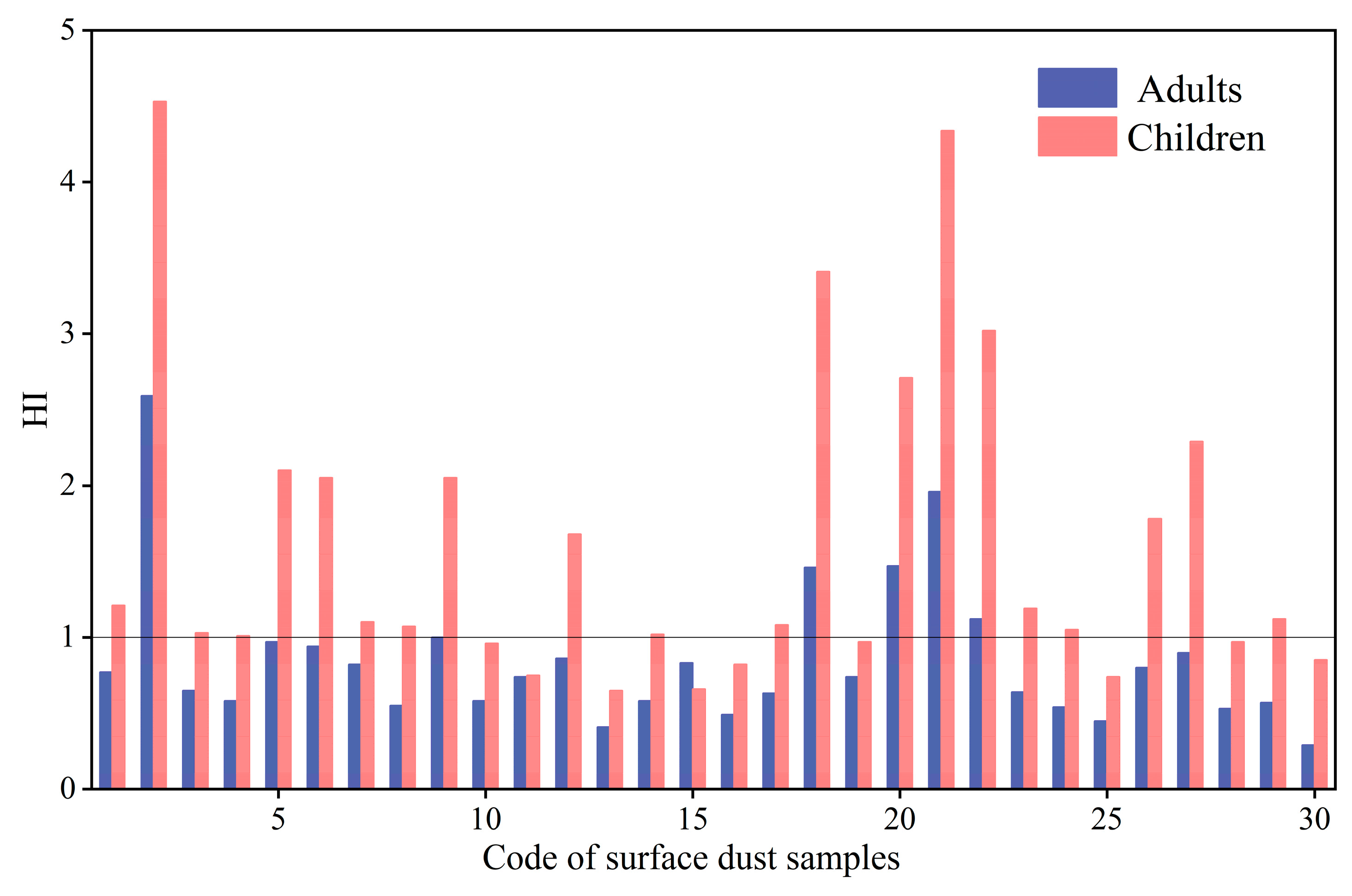

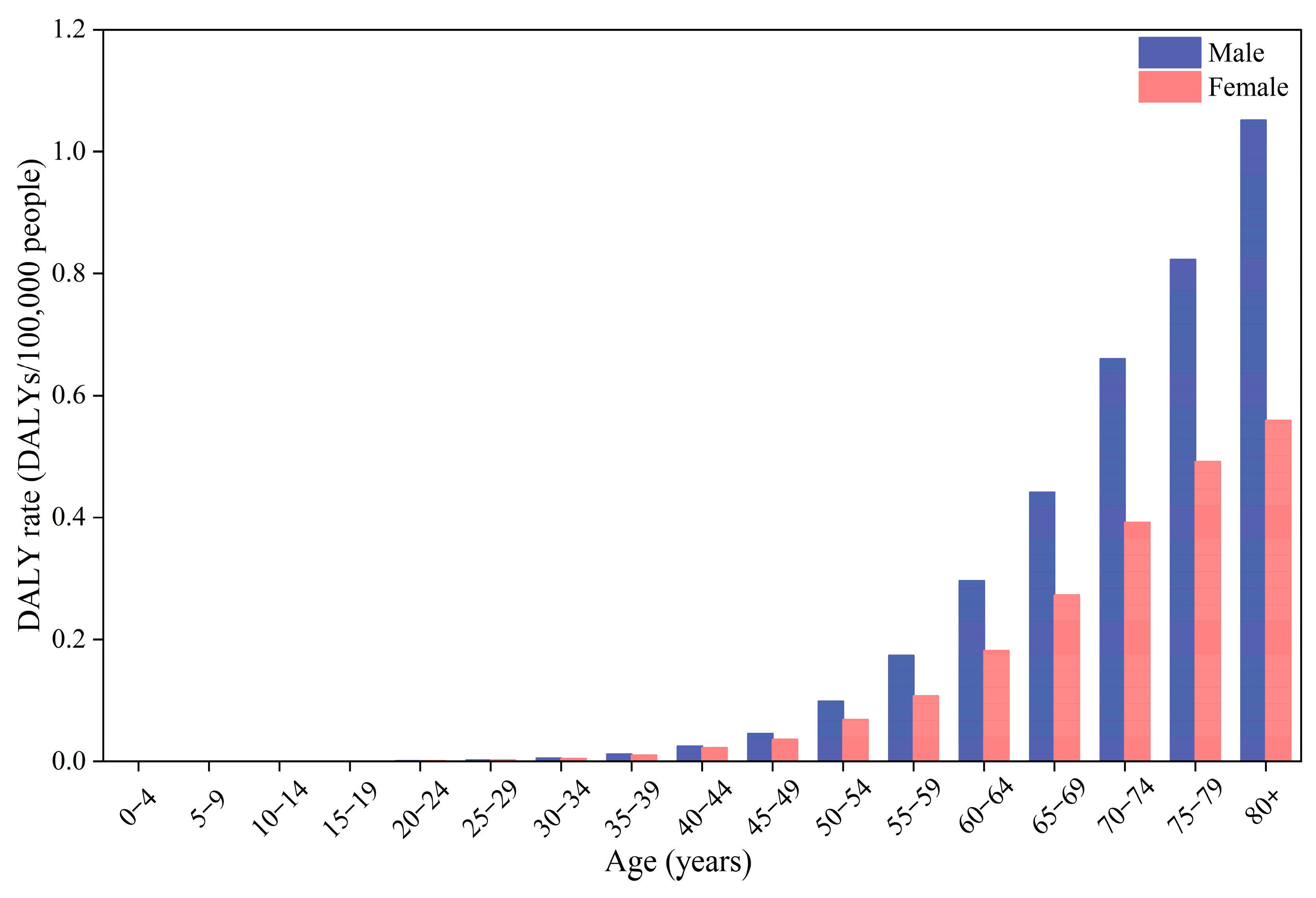
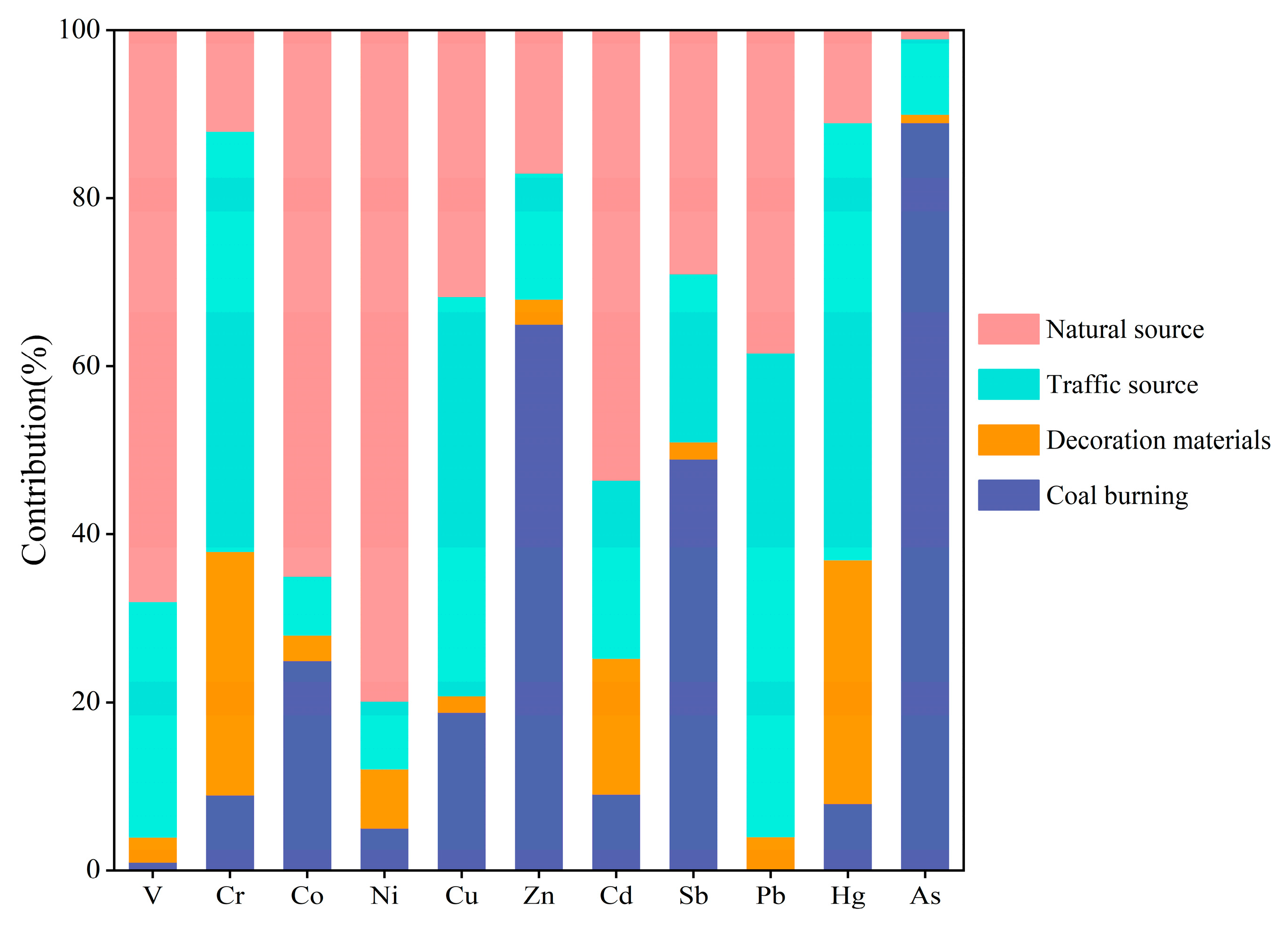

| Max | Min | Mean | SD | CV (%) | Background | |
|---|---|---|---|---|---|---|
| V | 185.55 | 37.53 | 68.06 | 33.69 | 49.50 | 84.33 |
| Cr | 565.12 | 48.7 | 126.48 | 100.14 | 79.17 | 46.51 |
| Co | 16.85 | 6.62 | 8.73 | 2.14 | 24.55 | 9.72 |
| Ni | 41.50 | 19.89 | 27.68 | 5.25 | 18.98 | 26.21 |
| Cu | 402.37 | 26.06 | 76.25 | 71.85 | 94.23 | 20.54 |
| Zn | 1274.64 | 98.99 | 287.07 | 225.44 | 78.53 | 77.21 |
| Cd | 2.55 | 0.32 | 0.74 | 0.47 | 64.32 | 0.3 |
| Sb | 23.15 | 1.15 | 4.28 | 3.85 | 89.83 | 1.27 |
| Pb | 943.84 | 22.54 | 172.67 | 202.06 | 117.03 | 24.58 |
| Hg | 0.967 | 0.016 | 0.24 | 0.27 | 112.19 | 0.022 |
| As | 38.873 | 4.060 | 8.66 | 5.96 | 68.77 | 8.04 |
| Toxic Metals | Male | Female | Total | |
|---|---|---|---|---|
| Cr | Ingestion | 1.71 × 100 | 1.01 × 100 | 2.71 × 100 |
| Inhalation | 1.06 × 10−2 | 6.22 × 10−3 | 1.68 × 10−2 | |
| Dermal | 5.13 × 100 | 3.02 × 100 | 8.15 × 100 | |
| Ni | Ingestion | 6.27 × 10−1 | 3.69 × 10−1 | 9.96 × 10−1 |
| Inhalation | 9.72 × 10−5 | 5.72 × 10−5 | 1.54 × 10−4 | |
| Dermal | 2.25 × 10−2 | 1.32 × 10−2 | 3.57 × 10−2 | |
| Cd | Ingestion | 1.21 × 10−1 | 7.14 × 10−2 | 1.93 × 10−1 |
| Inhalation | 1.88 × 10−5 | 1.11 × 10−5 | 2.99 × 10−5 | |
| Dermal | 4.49 × 10−3 | 2.64 × 10−3 | 7.13 × 10−3 | |
| Pb | Ingestion | 3.96 × 10−2 | 2.33 × 10−2 | 6.29 × 10−2 |
| Inhalation | 1.23 × 10−5 | 7.22 × 10−6 | 1.95 × 10−5 | |
| Dermal | 3.69 × 10−3 | 2.17 × 10−3 | 5.86 × 10−3 | |
| As | Ingestion | 3.50 × 10−1 | 2.06 × 10−1 | 5.56 × 10−1 |
| Inhalation | 1.33 × 10−4 | 7.79 × 10−5 | 2.10 × 10−4 | |
| Dermal | 1.26 × 10−1 | 7.43 × 10−2 | 2.01 × 10−1 | |
| Total | 8.15 × 100 | 4.79 × 100 | 1.29 × 101 |
Disclaimer/Publisher’s Note: The statements, opinions and data contained in all publications are solely those of the individual author(s) and contributor(s) and not of MDPI and/or the editor(s). MDPI and/or the editor(s) disclaim responsibility for any injury to people or property resulting from any ideas, methods, instructions or products referred to in the content. |
© 2025 by the authors. Licensee MDPI, Basel, Switzerland. This article is an open access article distributed under the terms and conditions of the Creative Commons Attribution (CC BY) license (https://creativecommons.org/licenses/by/4.0/).
Share and Cite
Wang, Y.; Chao, T.; Li, Q.; Jiao, Z.; Ruan, X.; Wang, Y.; Ge, S.; Wang, Y. Toxic Metals in Surface Dust in Underground Parking Garages: Pollution Status, Risk and Disease Burden Assessment, and Source Apportionment. Toxics 2025, 13, 895. https://doi.org/10.3390/toxics13100895
Wang Y, Chao T, Li Q, Jiao Z, Ruan X, Wang Y, Ge S, Wang Y. Toxic Metals in Surface Dust in Underground Parking Garages: Pollution Status, Risk and Disease Burden Assessment, and Source Apportionment. Toxics. 2025; 13(10):895. https://doi.org/10.3390/toxics13100895
Chicago/Turabian StyleWang, Yong, Tong Chao, Qidi Li, Zhiqiang Jiao, Xinling Ruan, Yuguang Wang, Shiji Ge, and Yangyang Wang. 2025. "Toxic Metals in Surface Dust in Underground Parking Garages: Pollution Status, Risk and Disease Burden Assessment, and Source Apportionment" Toxics 13, no. 10: 895. https://doi.org/10.3390/toxics13100895
APA StyleWang, Y., Chao, T., Li, Q., Jiao, Z., Ruan, X., Wang, Y., Ge, S., & Wang, Y. (2025). Toxic Metals in Surface Dust in Underground Parking Garages: Pollution Status, Risk and Disease Burden Assessment, and Source Apportionment. Toxics, 13(10), 895. https://doi.org/10.3390/toxics13100895








